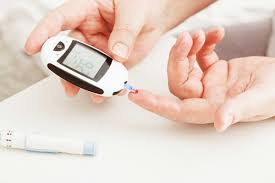In Recognition of American Diabetes Month (November) The A1C Test: So What’s in a Number?
Oftentimes, internists challenge patients with diabetes to ‘know their numbers’: “What is your blood pressure, blood cholesterol, blood sugar, and A1C number?” In recognition of American Diabetes Month, I’ve written a few Frequently Asked Questions (FAQ’s) to better understand the A1C, a blood test most important in diabetes long term care. Before the FAQ’s, I’ll present typical scenarios of patients from my medical practice.
I met Mr. H.H., when he was 54 years old. He had a heart attack a year before being diagnosed with diabetes. When diabetes was diagnosed, his A1C was 11%. Fortunately, Mr. H.H. acquired self-management skills rapidly, accepted insulin treatment, attended several diabetes education classes, and started a steady exercise program. As a result, after just 2 months of treatment, his A1C dropped to 6.5%. Three years have passed since the initial diagnosis and he continues to maintain an A1C less than 7 percent.
A 47-year-old lady, Ms. J.F., after a 2-year struggle with poorly controlled diabetes, finally reached an A1C of 6.8 percent. I sent her a congratulatory email and asked what she had done differently to achieve her goal. Here’s her response: “I was very happy to see my A1C under 7 finally. Just being careful watching carbs, taking insulin, and checking my blood sugar regularly.”
Mrs. A.J. is 42 years of age and was diagnosed with diabetes 5 years ago. I was her physician only briefly. At the time we met, her A1C was 18 percent! We entered into a conversation about diabetes management and the critical need to begin treatment with insulin. She declined insulin treatment and chose to stay on oral diabetes medications which at this point were totally ineffective. She explained that insulin therapy would impact her ability to care for her 3 young children as well as work 8 to 10 hours a day. I knew that her body would not be able to continue to handle this toxic amount of blood sugar. Unfortunately, 3 months later, she died from a massive heart attack.
I met Mr. R.M., 3 years ago when he presented to my office to establish medical care. At that time, he was 49 years of age and had been diagnosed 7 years earlier with diabetes. He was single, worked 2 jobs, ate meals at fast food places or diners, and slept about 5 to 6 hours a day. At his initial visit, his A1C was 9%. Upon review of previous blood tests, his A1C had not changed over the past 5 years. Plus, poorly controlled diabetes and hypertension had already damaged his eyes and kidneys. Even with these findings, he missed most office visits, would only call the office for medication refills, receive only limited refills until he followed up, sometimes missing or stretching medication doses until he carved out time for office visits.
What is an A1C test?
- The A1C is a blood test that measures how well one’s blood sugar has been managed over a 60 to 90-day period. In other words, the A1C is one’s average blood sugar over this time period.
- The A1C is also used to diagnose pre-diabetes or diabetes.
What is the difference between blood sugar testing and A1C testing?
- A blood sugar test is an indicator of blood sugar control a few hours before the test is taken.
- The A1C is an indicator of blood sugar control over 90 days. A normal A1C is less than 5.7 percent. An A1C between 5.7% and 6.4 % means pre-diabetes. An A1C of 6.5% means diabetes. You can use the table below to find your 90 -day average blood sugar based on the A1C.
| A1C | Estimated average glucose (blood sugar) |
| 5 | 100 |
| 6 | 126 |
| 7 | 154 |
| 8 | 183 |
| 9 | 212 |
| 10 | 240 |
| 11 | 269 |
| 12 | 298 |
| 13 | 326 |
| 14 | 355 |
| 15 | 384 |
| 16 | 412 |
| 17 | 441 |
| 18 | 470 |
Why is it important to know my A1C?
- Poorly controlled diabetes over a long period of time can damage the eyes, kidneys, and nerves in the body. Research shows that when the A1C remains at 7% or less, the incidence of complications from diabetes are less likely to occur.
- Poorly controlled diabetes is the most frequent cause of new cases of blindness among adults aged 20 – 74 years. It is also the leading cause of kidney failure in the United States.
- Poorly controlled diabetes narrows the blood vessels around the heart and brain. As a result, heart attacks and strokes occur more likely in people with diabetes than in the general population.
Since the complications from diabetes take years to develop, how important is the A1C at the time of diagnosis?
- Research demonstrates that getting a good handle on blood sugar management from the time of discovery lasts a long time. This is known as the “legacy effect” because there appears to be significantly fewer eye, nerve, and kidney problems in this population. Therefore, a reasonable A1C goal for many adults is less than 7 percent.
- In older persons (65 years) and persons with some chronic conditions, an A1C of 8 or less has been shown to be safer. Discussion with your personal care physician will help determine the best goals for each individual.
Recently, I was found to have pre-diabetes. What’s in store for me now?
- Knowing this number early on is good news. Simple lifestyle changes can result in delaying or even preventing the onset of diabetes. For example, I’ve had some patients move from pre-diabetes to normal A1C by just stopping regular soda, tea, or fruit juices. For example, one 12-ounce can of any of these equals 10 teaspoons of sugar. Not only does their A1C drop but their weight drops as well!
References:
American Diabetes Association Standards of Care 2015
New England Journal of Medicine “Legacy Effect” of Intensive Control of Type 2 Diabetes October 2008




